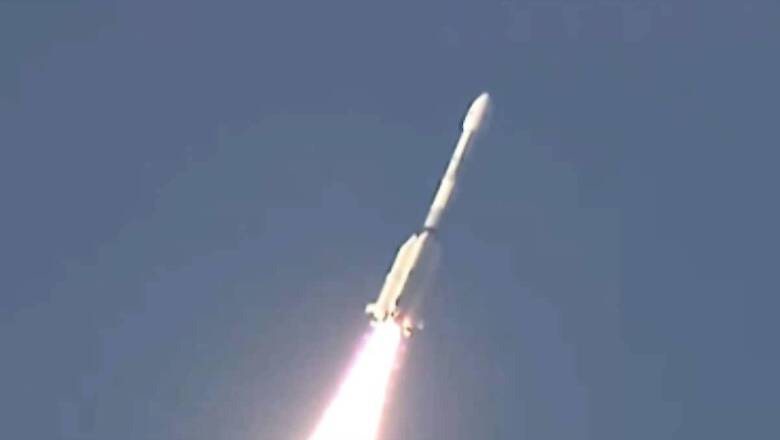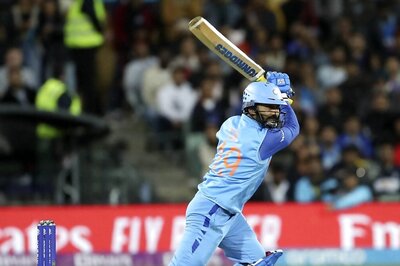
views
The Indian Space Research Organisation (ISRO) on Saturday launched its weather satellite INSAT-3DS board spacecraft Geosynchronous Launch Vehicle (GSLV) F14, nicknamed the ‘naughty boy’ for its spotty record.
The GSLV-F14 rocket lifted off at 5.35 pm from the Satish Dhawan Space Centre in Sriharikota, the space agency, which began a countdown for the launch on Thursday, said. The vehicle has successfully placed the satellite into the intended geosynchronous transfer orbit, ISRO noted.
#WATCH | Andhra Pradesh: ISRO launched INSAT-3DS meteorological satellite onboard a Geosynchronous Launch Vehicle F14 (GSLV-F14), from Satish Dhawan Space Centre in Sriharikota.(Source: ISRO) pic.twitter.com/abjPVJWkxh
— ANI (@ANI) February 17, 2024
#WATCH | Andhra Pradesh: ISRO chief S Somanath and other ISRO scientists congratulate each other after the successful launch of INSAT-3DS(Source -ISRO) pic.twitter.com/DcdTmig7YV
— ANI (@ANI) February 17, 2024
Following the successful launch, ISRO Chairman S Somanath said, “I am very happy to announce the successful accomplishment of the mission GSLV-F14 INSAT-3DS. The spacecraft has been injected into a very good orbit. We also noted that the vehicle has performed very well. Congratulations to everyone who has been a part of the team…”
#WATCH | Andhra Pradesh: On the launch of ISRO’s INSAT-3DS meteorological satellite onboard a Geosynchronous Launch Vehicle F14 (GSLV-F14), ISRO Chairman S Somanath says “I am very happy to announce the successful accomplishment of the mission GSLV-F14 INSAT-3DS. The spacecraft… pic.twitter.com/McbU9AJAuH— ANI (@ANI) February 17, 2024
This is the rocket’s 16th mission overall and its 10th flight using the India-made cryogenic engine.
GSLV-F14/INSAT-3DS Mission:27.5 hours countdown leading to the launch on February 17, 2024, at 17:35 Hrs. IST has commenced. pic.twitter.com/TsZ1oxrUGq
— ISRO (@isro) February 16, 2024
In its 16th flight, the GSLV aims to deploy INSAT-3DS, a meteorological and disaster warning satellite. The mission is fully funded by the Ministry of Earth Sciences (MoES), the space agency said in a statement.
GSLV-F14/️INSAT-3DS Mission:The mission is set for lift-off on February 17, 2024, at 17:30 Hrs. IST from SDSC-SHAR, Sriharikota.In its 16th flight, the GSLV aims to deploy INSAT-3DS, a meteorological and disaster warning satellite.The mission is fully funded by the… pic.twitter.com/s4I6Z8S2Vw— ISRO (@isro) February 8, 2024
The mission’s success will be crucial for the GSLV, which is scheduled to carry later this year the Earth observation satellite, NISAR, which is being jointly developed by NASA and ISRO.
According to a report by the Indian Express, at least four of the 15 launches using the GSLV so far have been unsuccessful. In comparison, only three of the 60 missions so far by ISRO’s workhorse PSLV (Polar Satellite Launch Vehicle), and none of the seven by its successor LVM-3, have failed.
GSLV-F14/️INSAT-3DS Mission:The mission is set for lift-off on February 17, 2024, at 17:30 Hrs. IST from SDSC-SHAR, Sriharikota.In its 16th flight, the GSLV aims to deploy INSAT-3DS, a meteorological and disaster warning satellite.The mission is fully funded by the… pic.twitter.com/s4I6Z8S2Vw— ISRO (@isro) February 8, 2024
The GSLV is a three-stage rocket that is 51.7 metres long – about a quarter of the length of the Statue of Unity, which stands 182 metres tall – and has a liftoff mass of 420 tonnes. ISRO plans to retire it after a few more launches.
The weather satellite is important for the nation as it will help boost India’s weather and climate monitoring services. Called INSAT-3DS, it is a third-generation upgraded, dedicated meteorological satellite. The satellite weighs 2,274 kg and has been built at a cost of about ₹480 crore. It is fully funded by the Ministry of Earth Sciences, said ISRO.
















Comments
0 comment